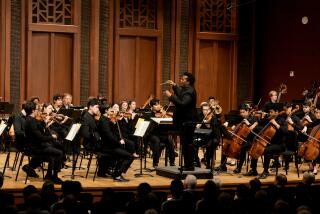MUSIC REVIEW : Mixed Works Conclude Chamber Group’s Season
Southwest Chamber Music Society has come a long way in its first eight seasons, which ended with twin events over the weekend.
The organization’s pool of splendid Southern California players remains secure--clearly, gifted musicians working in the vineyards of commerce appreciate opportunities to make art as often as possible--its standards high, its programs provocative.
At the first of these two closing concerts, Friday night at Chapman University in Orange (repeated in Pasadena, Saturday), the program offered welcome variety: Halsey Stevens’ String Trio (1959); a group of Purcell songs accompanied by lute and Baroque cello; Brahms’ autumnal but hot-blooded String Quintet, Opus 111.
This agenda achieved its climax, naturally, in Brahms’ ever-wondrous G-major Quintet, given by violinists Peter Marsh and Annie Chalex, violists Jan Karlin and Richard Elegino and cellist Roger Lebow a propulsive yet spacious continuity and bright overview filled out with telling details.
Brahms’ earthy passions and spiritual subtexts infuse all movements of this masterpiece, and these players re-created and integrated both aspects, with brilliant playing all around.
In Stevens’ touching and compact Trio--a work of neo-Classic terseness that the late composer said could be played by either winds or strings--similar strengths were achieved by Marsh, Karlin and Lebow, in an affectionate revival.
Despite a mid-performance string-breaking on James Tyler’s lute and a number of unclarified consonants in soprano Mary Rawcliffe’s enunciation, a quarter-hour of Purcell songs at mid-program nevertheless provided pleasure and contrast between the Stevens and Brahms works.
Robert Tueller was the articulate cellist in these four songs.
More to Read
The biggest entertainment stories
Get our big stories about Hollywood, film, television, music, arts, culture and more right in your inbox as soon as they publish.
You may occasionally receive promotional content from the Los Angeles Times.










